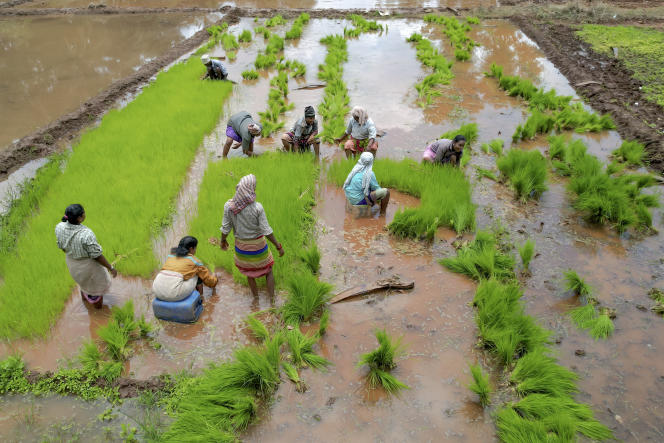The price of rice, which soared to its highest level in fifteen years, after restrictions imposed by India on exports of this cereal, foreshadows the way in which climate change will disrupt the world’s food supply, according to experts. Rice prices jumped 9.8% in August, offsetting declines in other commodities, the Food and Agriculture Organization (FAO) said last week.
It was the announcement in July by India, which represents 40% of world rice exports, of a ban on sales of non-basmati rice abroad, which ignited the powder. New Delhi justified this measure by a surge in rice prices on its domestic market caused by geopolitics, the El Niño climatic phenomenon and “extreme climatic conditions”.
This year is expected to be the hottest on record and the impact of the seasonal El Niño phenomenon could make the situation even worse. Despite severe flooding in parts of northern India, this August was the hottest and driest on record in the country. The monsoon, which brings up to 80% of the country’s annual rainfall, was much lower than normal.
The restrictions imposed by India in July follow an embargo in September on exports of another variety of rice, an essential food in parts of Africa. Up to 8% of global rice exports for 2023/24 could now be taken off the market, according to an analysis by BMI, part of the Fitch ratings agency.
Fears of a significant drought
For now, the crisis has offered an opportunity for Thailand and Vietnam, the world’s second and third largest exporters, to increase their exports. Nguyen Nhu Cuong, an official from the Vietnamese Ministry of Agriculture and Rural Development, welcomes a “exceptional harvest” and plans to increase plantings.
But the drought that accompanies El Niño could threaten harvests, worries Elyssa Kaur Ludher of the Southeast Asia Climate Change Program at the Iseas-Yusof Ishak Institute. “I think the end of this year and especially the beginning of next year will be very, very difficult”she warns.
El Niño, a natural weather phenomenon, typically lasts nine to 12 months and is expected to strengthen late this year. Even before India’s restrictions, its effect was driving up rice export prices, according to BMI.
In Thailand, rainfall is currently 18% lower than forecast for the period, the National Water Resources Authority said in September. Late rains could still offset the deficit, but the agency says “concerned” by a drought caused by El Niño.
“A question of social stability”
The impact is more on prices than on supply, notes Charles Hart, agricultural raw materials analyst at Fitch Solutions: “We are not witnessing a period of rice shortage. » This situation is likely to drain stocks replenished after the Covid-19 pandemic and to encourage importers to obtain new agreements and impose limits locally.
The Philippines, a major importer, has just signed an agreement with Vietnam to stabilize supply, a few days after announcing a price cap. But for the poorest, high prices mean less food. “It is also a question of social stability, it is a political question” to which leaders must be attentive, notes Elyssa Kaur Ludher.
Climate change can lower productivity, with agricultural yields falling as temperatures rise, but it also increases the likelihood of extreme events like the 2022 floods in Pakistan. “Global grain export markets are relatively concentrated, so this type of extreme climate risk is concentrated in a few markets”adds Charles Hart.
Partner service
Online English courses with Gymglish
Learn English in 10 minutes a day with fun, personalized lessons
Discover
In India, authorities need to develop better warning systems and new planting models, says Avantika Goswami, a climate change researcher at the Center for Science and Environment. “Raggy weather is the new normal”she warns.
